History
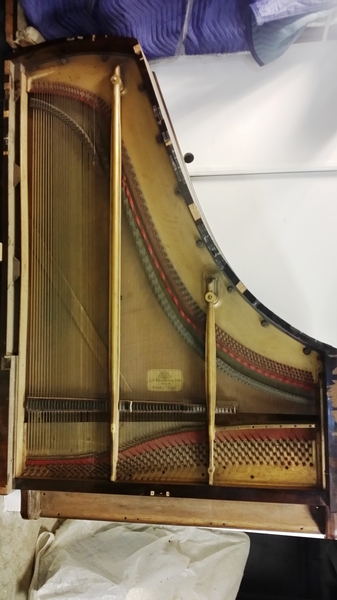
A Broadwood & Sons Grand, built in London. Waiting for the long road to restoration.
Notice the bass strings are not overstrung, like in modern grands. The concept, credited to Henry Steinway in 1859 meant economy of space. The iron plate structure is also an older design.
This piano probably dates from about 1840. Like square grands, the anachronistic design of these pianos limits their restoration to esoteric or sentimental collectors.
There is plenty of information available on the history and evolution of the piano. The modern piano was developed by the mid 19th century. The main hurdle was the cast iron plate, which holds all of the thousands of pounds of tension. It was not until late 1800s that foundries were able to create a pure cast plate that would hold the intense demands of the piano. The precursors, harpsichords and later square grands, were inefficient in this task. In any event, the cast iron plate, along with the pinblock, bridges, and the action have been virtually unchanged for almost 100 years.
 |
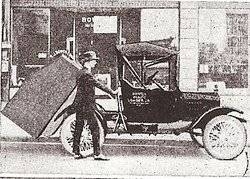 |
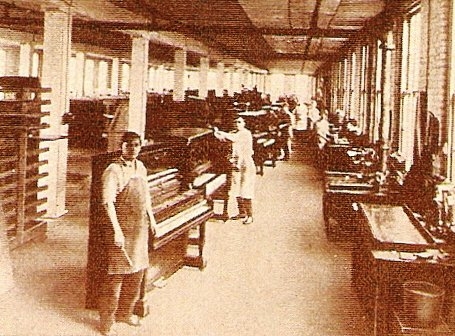 |
In this section I want to deal with the history of the Piano Industry in North America. Essentially its rise and fall, from its dominance, at its height of production of over 350,000 units and over 1000 manufacturers to today where there are only a handful of piano manufacturers in North America led by the classic Steinway & Sons Company.
At the turn of the century, the piano dominated the consumer landscape. The average upright sold for around $400, a princely sum since that was almost the average workers annual salary. However consumer goods produced on a large scale were virtually non-existent. Computers, TV, radios, even automobiles had of course not been invented yet. The piano industry promoted itself as an essential luxury. Owning a piano became a symbol of class and culture, as well as a focal point of family gatherings. In addition, the piano was added to the basic music curriculum. Satellite industries such as piano tuners, sheet music sales, and (of course) movers rose up to reply to the demand.
The piano is a complex item to produce. From the foundry to cast the iron plate to the tiny moving parts of the piano's mechanism, the manufacturing of the piano evolved from individual cottage industries producing dozens of pianos a year to large scale manufacturing and mechanization where larger companies simply bought out or merged with smaller players to boost production. Although piano production was located mainly in New York and Massachusetts, Montreal was home to several recognized factories. The most known Montreal company, Willis Pianos faded sign can still be seen today on 580 Ste-Catherine West. At their peak they pumped out almost 3000 pianos. In addition, the Craig Piano Company, Pratte Pianos, Langelier (Ste-Therese), David & Michaud, Lesage and of course the Layton Brothers (Jack Layton, the late NDP federal leader was a grandson of one of the Layton Brothers) were some of the major players in the Montreal area.
 |
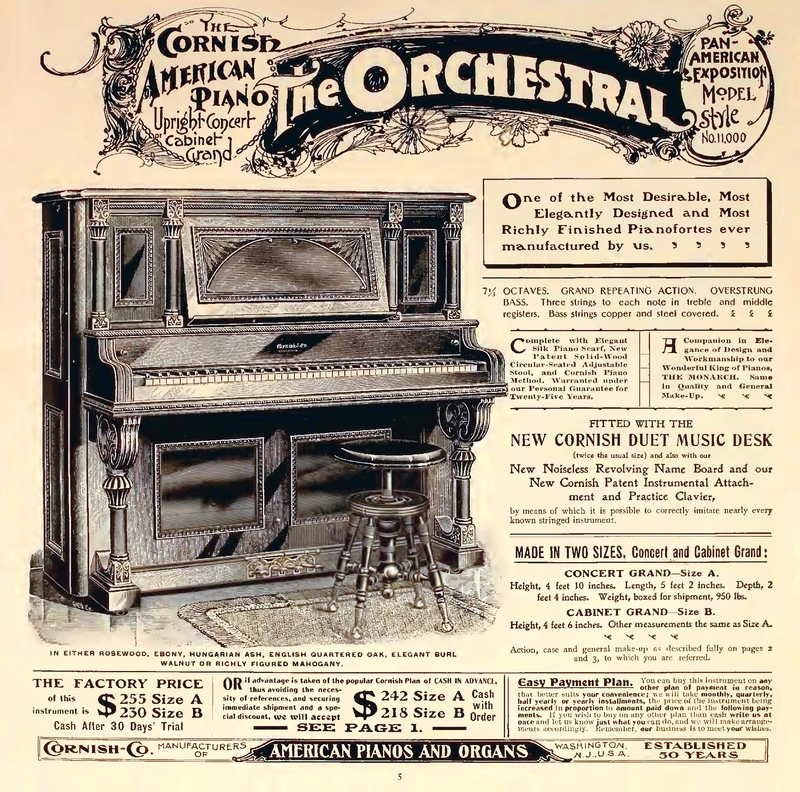 |
There were also dozens of smaller ateliers such as S.R. Warren, Oswald Michaud and Georges Ducharme operated local ateliers which produced makes such as Ducharme's Beethovan Pianos. Most of the smaller companies did not survive far into the 20th century as mass production favoured bigger players. Lesage Pianos acquired Craig Piano Company in 1930; Bell Piano in 1934; and Weber Piano in 1939 producing pianos under a variety of names such as Bell, Mendelssohn, Schumann and Belmont.
A combination of The Great Depression, and the invention of radio and the automobile pushed luxury items like the piano to the back burner. Piano manufacturing basically fizzled out after the war to the point today that there are no Canadian companies producing new pianos. US production is limited to Steinway and Mason & Hamlin. Like most of our products today, China is the source of most of the pianos we can buy today.
The fact that older pianos are still available readily to any that will take them (and they still work) is a testament to the quality of workmanship. The piano industry was one of the first large scale items manufactured specifically as a non-essential consumer good. The beginning of The Golden Age of North American manufacturing.
 |
 |
The once ubiquitous piano built in Canada is gone, but it still remains a silent witness to a bygone era.
Historical record of moving pianos is difficult to find. However, the horse and carriage and ropes were eventually replaced by trucks and dollies. Hoisting a piano up to the second floor would have been done with a pulley system. Movers had to deal exclusively with large ornate upright pianos until about the middle of the century.
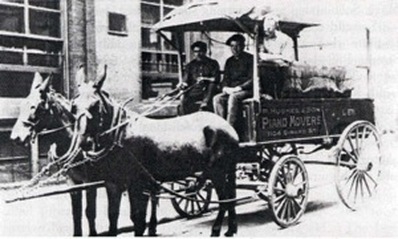
Caring
The piano is basically a wooden case with a cast iron plate. Strings stretch from one end to the other and an action, or mechanism which, strikes the strings which makes the sound. Remember the piano is in fact a percussion instrument. There are more than 9000 individual parts on the action alone. The 200 + strings on your piano has a combined tension of over eighteen tons! The action of the piano is a remarkable piece of late 19th century technology that has remained virtually unchanged to this day. Modern pianos still use wooden action parts on a cast iron plate.
1.Where to put your piano
The single worst place for your piano is near a radiator or over a heating vent. The hot air blowing or radiating into the piano will place enormous stress on the piano since the temperature and humidity will not be constant. It is amazing how fast heat will literally destroy any piano.
It is advisable but not necessary to avoid placing the piano near a window. However as long as sunlight does not heat the surface of the piano you will be OK.
Modern insulation has made the old “not beside an exterior wall” rule obsolete.
Windows are also much better insulated today so the only concern is that if you MUST place your piano near a window which allows a lot of light is to use a blind or curtain. You have probably experienced this effect with a coffee table or even curtains exposed to light over a long period of time
One client’s interior designer insisted that a piano be placed directly in front of a bay window to complete the room. Not two years later we were picking up the piano to be refinished. The sunlight had dried out the high polished black lacquer finish reducing it to what’s referred to as “alligator skin”.
2. Cleaning
Avoid furniture polish, especially ones that contain silicone. Micro fiber (new fabric which is soft, absorbs well, and leaves no lint) will clean but not leave lint or damage the finish. Lacquered pianos (highly polished finish usually Black) are very fragile and easy to scratch.
- Cleaning the keys:
Yellowed keys are usually ivory which has aged. Like your teeth, it is next to impossible to remove the yellow completely however a qualified technician can sand and polish your keys. Any piano manufactured in the last 30 years has plastic keys which can be cleaned by using a mild detergent solution and a moist micro fiber or other soft cloth (too wet will drip water between keys which will warp the keys). Use a different cloth to clean ebony (black) keys.
- Cleaning the “inside”
The piano’s action is very fragile and therefore its cleaning should be left to a piano technician. Grands are particularly prone to collect dust especially if the lid is always left open. Dust and grime can collect over the years and is extremely difficult to remove. Usually a pipe-cleaning tool is used. The task is tedious, lenghly. To avoid this problem, simply close the lid and key cover when no in use.
3. Temperature and Humidity
A common misconception is that a piano should be stored at room temperature or more. The most important element in keeping the piano in good shape is the relative humidity. Exposed to annual Extremes of humid summers and dry winters, the piano will quickly show its age. It is striking to see the difference with pianos seventy-five years old maintained at a constant humidity versus one stored in the damp basement or in an overheated room. Sudden changes in humidity puts enormous stress on the piano since the parts shrink or swell with changes in humidity which can result in strings rusting; glue drying out; parts breaking etc. Most of the action is in fact wood moving parts.
THE MOST IMPORTANT FACT, ESPECIALLY FOR OUR CLIMATE, IS THAT HOT, DRY AIR IS ENEMEY NUMBER 1 OF THE PIANO. I always tell the story of a tuner colleague of mine that was tuning a piano in early December in preparation for the holidays when the family would gather around for sing-a-long. The piano was placed in the middle of a wall. There was an indent in the wall for what was formally a space for a pot-belly stove, or a built in armoire that was long removed. The tuner had returned a year later to observe that the piano was basically still in tune. The conclusion that the piano was in an area that was not exposed to any moving air underscores the importance of keeping the piano in a constant temperature and humidity.
There is a varying of opinions as to the ideal humidity for a piano. In our experience anywhere between 35% to 55% is ok, but the most important is to keep it as constant and stable as possible throughout the year and not allow wild swings outside of this range. In winter, it is in fact better to keep the room cooler, as colder air will hold more humidity.
Modern heating/cooling systems are equipped with humidity control, which draw water out of the air in the summer and humidify the air in the winter. If you are not one of those fortunate souls with forced air heating you may want to opt for a portable humidifier or a specialized piano humidification system called a Dampp-Chaser. The system, which usually costs around 300-500 dollars installed, will automatically control the humidity of your piano
4.Storing
If you are storing your piano, ask about the conditions at the storage. Never store your piano in an unheated facility. Storing a piano for more than a couple of days in subzero temperatures can cause irreparable damage to the instrument. In addition, humidity should be maintained constant (around 45%).
Moventune does do short and long term storage. We provide a climate-controlled environment.
5.Tuning
Your piano should be tuned at least once a year. Concert pianos are tuned several times per month and always before a concert. We usually recommend waiting at least a few days before tuning a piano to allow it to “settle” into its new home. We offer discounted rates for all of our clients who move pianos with us.
Buying
A piano can have up to ten thousand parts. This fact alone can make buying a piano intimidating, to say the least. This section will provide the prospective buyer with a basic orientation of the piano market for those who have little or no experience in the field. This section gives some very general advice on piano terminology and major pitfalls to avoid.
If you are buying for a beginner, you may not want to invest a lot of money in your first piano. But resist the temptation to pick up an old clunker someone is giving away. Aside from open ended costs which may amount to more than the cost of a good quality piano, the beginner pianist will become quickly frustrated with sticking keys, broken strings, stuck pedals and other annoyances which will inevitably sap their motivation and your wallet.
Pianos tend to be excellent investments if you choose wisely. If your attempts to learn to play fall flat, you can usually resell the piano for close to what you paid for it.
It is important to take into account the following:
1. Space:
- An upright piano is just over 5 feet wide and between 3 and five feet high and 2 to 2 ½ feet deep. If you allow an additional 2 feet for the bench you can count on a total of 5 feet by 4 ½ feet of floor space in your apt or house.
- Grands are usually about 5 feet wide (the keyboard) and between 4 ½ to 9 feet in length for a concert piano. Unless you are a professional musician a 5 to 6 foot grand is best for most homes. Therefore when you add the 2 feet for the pianist and bench a grand takes up around 8 X 5 feet of floor space.
- It is highly recommended to place a piano well away from heating vents or radiators; direct sunlight; fireplaces; drafty windows or doors.
Failure to heed this warning will at the very least make it difficult to keep the piano in tune and in a worst-case scenario lead to premature structural damage to the instrument. I have seen the ravages of heat and sunlight on several occasions. One client took the advice of his interior decorator and placed his 7-foot Yamaha grand piano in the bay window. When we came back to move the piano only one year later, the lacquered finish had become what’s called “Alligator skin”: The finish had been dried out by the daily sunlight resulting in fading and cracking (resembling the skin of an alligator). It was obvious that the sun had been responsible since when you closed the lid of the piano, the finish, which had not been exposed, remained the original colour and glossy finish.
- Grand pianos need more space than uprights for aesthetic reasons whereas uprights can usually find a spot tucked into a corner or against a wall.
More often than not clients are surprised by how much space even a 4 ½ baby grand requires. It will appear awkward if a grand is squashed into a corner with couches and tables all around. In my experience, a grand piano looks best when ample room (2 to 3 feet) is left around the piano.
One way to verify how a piano will look is to make a cardboard cutout of your piano and arrange it accordingly. Failing that you may want to use a double or queen size mattress as a guide!
2. Furniture
- If you are buying a piano as a piece of furniture, you may be disappointed in the value you are getting. Many clients have told me that the piano “just needs a tuning”; “it’s an antique”; or “it has a beautiful shiny black finish”. The piano is, first and foremost, a musical instrument and its value is relative more to its function as a musical instrument and secondly as a piece of furniture.
- We have one piano in our warehouse with spectacular refinished mahogany with ornate legs and cabinet. The piano was refinished by a furniture maker who didn’t touch the mechanics of the piano and as a result the piano, to any half-serious pianist, would need to be overhauled completely to make it worth anything.
3. Cost
If you cannot afford to buy and maintain a good-quality piano, then wait and save rather than settling for a poor one.
- Grands are usually four to six times more than an upright.
- Old uprights, which have been repaired or restored can range from $1500 to $3500 for a high end restored completely.
- New uprights usually come from Korea, Japan, or more recently China and range in price from $3000 to $7000 for a new Steinway upright.
- Grands start at $7000 new or $4000 restored and up.
- Free old uprights. As the saying goes: “never look a gift horse in the mouth” However, in the case of pianos, when you consider the cost of potential repairs, tuning, and moving (of course), the free piano may be more trouble than it is worth.
- People usually give pianos away if they are no longer using them so you can rest assured that the piano has not been serviced or tuned for years.
- Ignored pianos are usually stored in basements or drafty, humid or overheated corners of the house or garage which may cause extensive damage to tuning pins, soundboard and the finish. In this case a low quality piano will cost you more in the long run, not to mention rob you of your enthusiasm.
- See listed Webpage for more detailed discussion on the subject https://www.casebrothers.com/
- Maintaining a piano in good condition costs between $100 and $200 per year.
